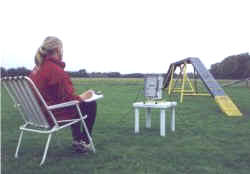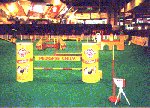Time and time
again...
 Electronic
timing has already been used this year at quite a few shows around the UK. Altogether the
Tarytimer system has been booked by more than 40 clubs for shows stretching from Longleat to
Aberdeen and Pembroke. Developer Martin Pollard reports that the general handler reaction has
been the best that can be hoped i.e. complete, seamless and immediate assimilation. It's as if
it has always been there. Time and time again... and again... and again. Electronic
timing has already been used this year at quite a few shows around the UK. Altogether the
Tarytimer system has been booked by more than 40 clubs for shows stretching from Longleat to
Aberdeen and Pembroke. Developer Martin Pollard reports that the general handler reaction has
been the best that can be hoped i.e. complete, seamless and immediate assimilation. It's as if
it has always been there. Time and time again... and again... and again.
One attribute that
Martin didn't predict is that throughput has gone up, some reckon by 20%. Manual timers often
have to walk from start to far finish, then back again to tell the scribe the time. The time is
presented to the scribe in easy to read digits, not a voice sometimes difficult to hear above
the usual din. Shows are finishing earlier, again not presenting as an obvious virtue, but not
lost on some club managers. With Taryntiming judges set finishes much farther away than with
manual timing. This must predicate more varied and better (?) courses.
We are servicing well
over 40 shows stretching from Longleat to Aberdeen to Pembroke and now have six regional reps.
How to use
For anyone who will be using electronic
timing for the first time, here are some guidelines for judges, ring parties and clubs, written
by Chris Smith and based on her experience as a judge. Martin Pollard has added a few extra
points to her article, some of which have arisen from taking round timing to Shows in 2000.
The manual
Taryntimer timing is accurate, reliable, easy to set up, and extremely simple to
use. However, there are some factors which should be taken into account when designing your
course if you wish to avoid some of the pitfalls. The following guidelines may help you to
achieve a class which runs smoothly and gives you a hassle free day!
 1.
Factors affecting course design. 1.
Factors affecting course design.
Electronic timing substantially decreases the time it
takes to get through a class. In order to make use of it to the best advantage it is
essential to have a separate start and finish.
Ideally the timing heads are best positioned at the wings
of your first and last jumps. Other obstacles may be used, see below.
A good straight start and finish is preferable to avoid
problems associated with dogs running outside the beam.
In particular avoid
inviting a ‘run by’ with your first obstacle, as you will not be able to fault this
because the time will not have started. In certain classes it may be helpful to put an extra
pole on the start jump.
Don’t use the
finish jump twice in the course as going over the finish jump will stop the clock. The start
jump can be used more than once.
You can have the timing mounts standing alone as a start
or finish line, but there is a maximum distance they can be separated, and this can lead to
problems of dogs running outside the beam or handlers running through the beam before the
dog.
Although jumps are the ideal start and finish obstacles,
frame (open or close) tyres, and tunnels can be used.
Weaves can give handling problems; long jumps are fine for starts but some dogs jump
over the beams when finishing; lollipop tyres cannot be used as the timing heads confuse the
dogs.
Pairs and teams. At the moment* pairs can only be run if two ‘finish’
jumps are used; the first dog jumps over an untimed jump into the box, the second dog
goes over a jump with timing heads recording the total
time. Timing can be used for teams where individual
dogs are timed. *(Mark 2 Taryntimers will cater for pairs and four dog aggregate time teams
later in 2001).
 2.
Starting competitors and recording the time. 2.
Starting competitors and recording the time.
It is becoming common practice for the scribe to write
down the time on the slip. When briefing your scribe, emphasise the importance of getting the
time down quickly – if the next competitor’s dog takes off, the time will be erased.
You will need to give quite a bit of thought to where to
locate your scribe as it is almost certain that he/she will have to remain seated throughout in
order to check the timing console. The scribe will therefore need to be in a position where
he/she can see your signals, see the timing console, and be near enough to the start jump to
start the competitors without getting in their way.
If the class is large, and there is time and space pressure
on the ring, for example a large class at an indoor show, it is advisable to ask a ring party
member to start the competitors thus taking pressure off the scribe.
This person can then assist by taking leads to
the finish area.
3.
Things you may consider mentioning in your
briefing
 4.
Course changes and problems 4.
Course changes and problems
Points at course changing time.
5. Run-bys at the start and finish gates.
If a dog
runs by the start gate or goes through the first jump under the beam, there appear to be three
ways (at least) to apply the marking regulations.
- The
dog has not started the clock, therefore it has not started the course.
Action: Start again, no penalty.
-
The dog has taken the wrong course.
Action- Start again, five (5) faults penalty.
-
Actions in a. and b. are unfair to other dogs because the clock is not running
when the dog is taken back.
Action- Elimination.
Similar
situations can occur at the finish gate.
Problems?
If the timing stops working for any reason, please call for the Taryntimer
representative immediately. The most likely causes have
proved to be misalignment, or obstruction of the beams by part of an obstacle.
However, if a fault has developed, we will not try to mend
it but will substitute back up equipment. This should take only a few minutes.
If you require help or advice on site please contact the
Taryntimer representative. If you have any worries or queries about timing with our electronic
system, please ring, email or write and we’ll be happy to help.
 If
you have any comments or suggestions after using the system, we should be very pleased to hear
them. If
you have any comments or suggestions after using the system, we should be very pleased to hear
them.
From Martin Pollard
Grateful thanks to
Chris Smith and to the clubs who gave us facilities last year as well as those intrepid people
of East Anglia, Shelley Christmas and Sandy Bell with whom Chris discussed this guide. Perhaps
at some time in the future the marking regulations will need to be modified to deal with
electronically timed starts and finishes. What do you
think?
Test Your Reflexes
If you are still in doubt about the
advantages of electronic timers, try this simple - and addictive - test which was sent by
someone on the AGILE list. Go to
http://www.happyhub.com/network/reflex/ and have fun.
From John Leslie...
Great fun -
hadn't tried the reflex test before.
Given that in most agility
situations where electronic timers are NOT in use, competitors are being timed by the same
person with the same equipment, the crucial thing is not so much the speed of response (or even
lack of it) as the consistency of response. I was alarmed to find that as hard as tried, my
reaction time varied between .27 and .44 seconds - with total concentration. In real life that
.17 seconds can be the difference between 1st place and 6th or lower... And when I relaxed my
focus even a tiny bit the difference was well over 1.5 seconds.
Thanks Taryntimers. May you go
from strength to strength. (18/11/01)
From Barbara Rogers
I would have even more fun with this than I had, if it wasn't that I am totally shocked and
alarmed at how slow I am! At least I think I'm slow. I played with it for a bit, and apparently
which COLOR I choose is a huge factor - I could NOT get below .33 with the
deep pink, no matter how hard I
tried many times - most of them were right at .33. But as soon as I switched to
medium slate blue, I got down to .27 seconds? This is
entirely new to me, that color makes a difference on how fast I respond? Now I am wondering if
some folks experienced the opposite, and were faster with hot pink?
Well, I guess if we knew the test results on a whole
bunch of us, then we could bring a variety of colored T-shirts to trials - you find out who is
timing your most important runs, and if it's me, where that medium
blue shirt!
And the test is right - it is addicting!
From Lisa Hesketh
Very addictive! I also got the fastest time with the blue colours.
Forget the blue T-shirt I'm off to get me a "blue" merle! (15/02/01)
From Jean Owen...
It is very scary to see how slow may responses were BUT it make total
sense why you can never change timers during a class!
From Mary Jo Sminkey
My reaction time as well was pretty consistent (although still not to
the 1/100th of a second). However, one thing to keep in mind with this test is that you have no
idea at all when the color change will happen. In agility, you usually can see the dog coming,
and I think that would result in at least a slightly better time. A better test would be one
where there was some indication that the change was coming. But still is a pretty good
illustration of how slow us humans really are.
From Chris Schultz
Another test to try. Get a stop watch. Start the timer and wait until it is at 10 seconds. Stop
the watch. Makes you think about that 5-second table count...
From Lynn Smitley...
As a phys. ed. major in college many years ago, when stopwatches had
sweep-hands and were spring-wound, we were taught that the 'trigger finger' of the dominant
hand had the fastest reaction time and we were NEVER to use the thumb.
It seems that these days most stop watches are designed
for using the thumb. When I time, I find it difficult to get my trigger finger positioned on
the stop/start button, and I never see any timer using anything but the thumb. (Not that I've
done an exhaustive survey.) It could be that opinions about the reaction time of the thumb have
changed more recently although, physiologically, it makes sense to me that the trigger-finger
would beat out the thumb for most people on reaction-time tests.
From Lyn Kalinoski
There is no timing system that is 100% idiot proof or infallible for
every single run.
From Kent Mahan
Electronic timing systems--more trouble and expense than they are worth in most cases.
|